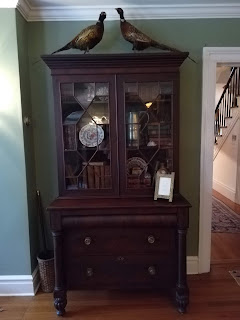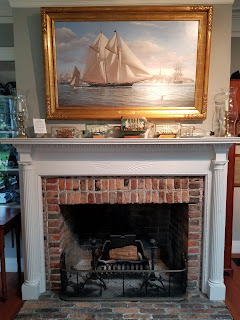Trip to the Southampton Historical Museum (and Tiana Beach)
by Nancy Liang
I’ve never been to a museum where the exhibits are displayed in what used to be someone’s house! The Rogers Mansion is filled with furniture and decorations from the Victorian Era. Wandering around, I found I preferred this style of museum because I was able to examine artifacts in context, in the environment that they were meant to be in. (19th century embroidered throw pillows are a lot more fun when you can flop around on them instead of just view them from behind a glass display case — and yes, I checked that we could touch them!) Most of all, I appreciated the way that the pieces in the mansion fit together to tell a story about the living conditions of the family and the social values of their time period.
The dress in this picture is very long and tightly cinched at the waist. The long folds of fabric hinder mobility, which indicates that the woman wearing this dress did not have to work to support her family. The hem of the dress would get dirty from dragging on the ground, so the woman who owned this dress likely did not walk around the city very often and could afford to replace dresses whenever they became stained from debris on the street.
This bookcase holds piles of maritime books, some china plates, and a few shells. From looking at this case, our professors were able to discern that this family was well-educated, wealthy, and well-traveled. The bookcase is a subtle way to display the family’s wealth and cosmopolitan lifestyle.
I learned quite a lot about how to gather information from different historical sources. I used to think that historical information was only gathered from people’s journals or government records. However, during this class trip, I became more aware of how historians can piece together information about people and time periods from things as overlooked (by me, at least) as clothing length and house decor. This trip was an all-around wonderful experience, and I can’t wait for next week’s trip.
Side note: I also learned that we would be on local news! A Channel 4 film team stopped us while we were at Tiana Beach learning about wave-action and observing the smaller effects of the (thankfully still very far away) Hurricane Dorian. Professors Bretsch and Rider gave an interview about Semester by the Sea to the news crew.
Hurricane Dorian Coming to Southampton
by Meaghan Sullivan
On September 6, 2018, the Coastal Cultural Experiences Class visited both Tiana Beach and Ponquogue Beach on the Southshore of Long Island to discuss the effects of the storm that was Hurricane Dorian would have on the beaches. The discussion started off with a little background on hurricanes in general. We learned that hurricanes in the Northern Hemisphere move in a counterclockwise rotation and typically move to the right due to the Coriolis Effect. The center of the hurricane has a lower pressure than the outside of the system, therefore causing air to rise and wind to be sucked in from the sides.
While at the beach, we observed that the winds were coming from the east and the waves were moving in a southeast direction. This caused us to move into a discussion about how the sand would be affected by these factors. We learned about something called long-shore drift. This is the movement of sediment along a coast that is caused by the waves coming in at an angle. On the south shore of Long Island, the sand is moved to the west. The storm would not only make the sand move westerly, but it would also create small sand cliffs known as scarps. This caused from the erosion of the sediment by the waves. Unlike the ocean, the Shinnecock Bay was a lot more protected from the storm. Because it is partially surrounded by land, the water is usually much calmer and less likely to experience major damage or change from storms.
Overall, I believe that this was a great experience for the group, especially for the ones not from the Long Island area. Being from Long Island myself, I still found it exciting because its not usual of me to go to a beach on a day that isn’t hot and sunny. We even got to be on the Channel 4 News, which was a great opportunity to advertise the Semester by the Sea Program and to teach people valuable information about our Long Island beaches.
 |
| Photo Citation: Meaghan Sullivan (2019) |
 |
| Photo Citation: Meaghan Sullivan (2019) |
The Wondrous and Elegant Life of the Parrish Family
by Mateo Rivera
Picture 1 (Piano): What other house do you know to have 3 pianos? This portion of the Rogers Mansion was mainly utilized for the entertainment of guests, although it wasn’t the only one. The amount of comfort and the attention to detail speaks volumes about the level of wealth in this gilded era.
Picture 2 (Ship): Being a well-established whaling family, the Parrish’s were displaying their interest in yacht racing. The painting of the S.Y. Henrietta beings this fascination to life. If that wasn’t enough, tiny ships are bordering the underside of the artwork.
Picture 3 (Dining Room): Welcome to the fine dining area of the Parrish household! In my opinion this was my favorite part of the mansion. Elegance is the essence that the table set brings this central gathering place of this family. The time period was a perfect example of what we now call classy dining, as dishware like this is still utilized in some homes in the modern day.
Punishment of the Past
by Tiffany Cui
For our last stop at the Southampton History Museum, we journeyed outside in the rainy and slowly picking-up winds (courtesy of Hurricane Dorian) to a part of the courtyard where two wooden structures were brandished on display. Slightly eerie looking with the backdrop of the gloomy weather, we settled around them as Professor Rider explained what they were. Devices made for punishment! Not particularly of the violent kind, to my honest surprise (I thought they were whipping posts at first), but pillories and stocks, as they were called, were placed in town centers and more for public shaming for transgressions ranging from missing church service to more extreme offenses.
Although the purpose of these structures was mostly for public humiliation, sitting or standing while strapped in one of these things could’ve also been extremely uncomfortable. One brave student volunteered to sit in the stock, and after only a few minutes he started shifting around uncomfortably. If it was uncomfortable after a few minutes, I couldn’t imagine how painful it might’ve felt after hours of sitting/standing there. This was more of an darker aspect of life during the time period, but it was interesting to look at how crime, petty or serious, was dealt with in the past.
 |
|
Pictured above is a Stock, which functioned by locking the captive’s feet between two holed slabs of wood and left there for public ridicule, often for hours on end.
|
Rogers Memorial Mansion in Southampton, New York
by Tessa Reynolds
Photo #1:
Nineteenth century dresses with work with full length skirts that covered the ankles. This made it harder for women to walk around, as the dresses would drag and end up dirty at the bottom. This fashion was better suited for upper-class women who didn’t walk around outside as much as working-class women.
Photo #2:
A tea break in the afternoon was used as a show of class and status. Those who partook were well off enough to stop their activities and take a break, something the working class was unable to do during the day.
Photo #3:
Families in the nineteenth century would decorate their homes in a way that displayed their identities and what they did for a living. The Rogers family were whalers and used marine aspects to decorate their home and show off their travels.












